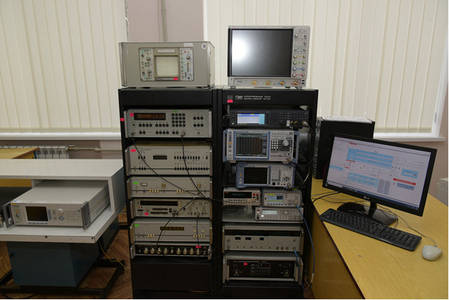National (State Primary) Standard of the Unit of Frequency Deviation of Frequency-Modulated Oscillations
Transferring of the size of frequency deviation unit to secondary and working standards by means of comparison with the help of comparator in accordance with DSTU 3392-96 (GOST 8.232-97) “Metrology. National verification scheme for measuring instruments of frequency deviation”.
The range of values of the frequency deviation ((f), which reproduces, stores and transmits the standard:
- from 10 Hz to 1 MHz - the main range;
- from 1 MHz to 8 MHz - extended range.
Modulation frequency range F:
- from 20 Hz to 200 kHz (main range);
- from 200 Hz to 500 kHz (extended range).
Carrier frequency range: 10 MHz, 50 MHz, up to 6 GHz.
Metrological characteristics | ||
Range | From 10 GHz to 1 MHz | from 1 MHz to 8 MHz |
Uncertainty by type А (uA) | 3⋅10-4 Δf | (3–5)⋅10-4 Δf |
Uncertainty by type В (uB) | (0,2–0,4)⋅10-3 Δf | (0,54–0,97)⋅10-3 Δf (1,1 – 1,9)⋅10-3 Δf |
Total standard uncertainty (uC) | 5⋅10-4 Δf | (5–12)⋅10-4 Δf |
Extended uncertainty (U) | 1⋅10-3 Δf (k = 2, p = 0,95). | (1–2,5)⋅10-3 Δf (k = 2, p = 0,95). |
Equipment that is part of the standard:
- frequency meter R&S HM8123,
- Keysight 336611A signal generator,
- vector generator Keysight N5172B,
- Keysight MSOS204 oscilloscope
- R&S FSV4 spectrum analyzer





